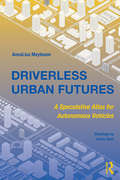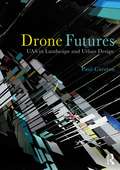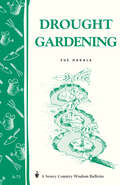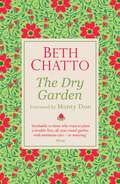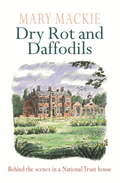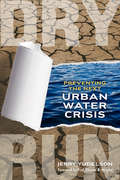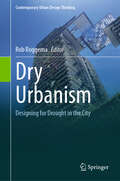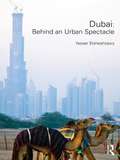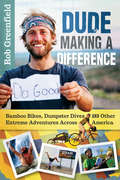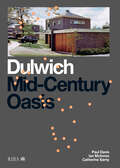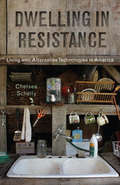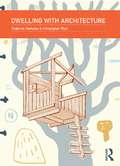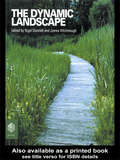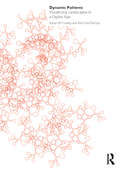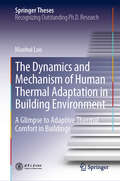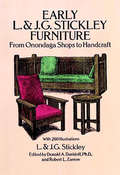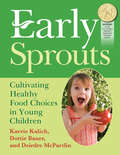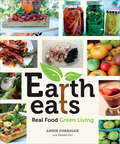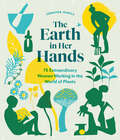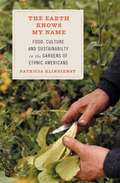- Table View
- List View
Driverless Urban Futures: A Speculative Atlas for Autonomous Vehicles
by AnnaLisa MeyboomSince the industrial revolution, innovations in transportation technology have continued to re-shape the spatial organization and temporal occupation of the built environment. Today, autonomous vehicles (AVs, also referred to as self-driving cars) represent the next disruptive innovation in mobility, with particularly profound impacts for cities. At a moment of the fast-paced development of AVs by auto-making companies around the world, policymakers, planners, and designers need to anticipate and address the many questions concerning the impacts of this new technology on urbanism and society at large. Conceived as a speculative atlas –a roadmap to unknown territories– this book presents a series of drawings and text that unpack the potential impacts of AVs on scales ranging from the metropolis to the street. The work is both grounded in a study of the history of urban transportation and current trajectories of technological innovation, and informed by an open-ended attitude of future envisioning and design. Through the drawings and essays, Driverless Urban Futures invites readers into a debate of how our future infrastructure could benefit all members of the public and levels of society.
Drone Futures: UAS in Landscape and Urban Design
by Paul CuretonDrone Futures explores new paradigms in Unmanned Aircraft Systems (UAS) in landscape and urban design. UAS or drones can be deployed with direct application to the built environment; this book explores the myriad of contemporary and future possibilities of the design medium, its aesthetic, mapping agency, AI, mobility and contribution to smart cities. Drones present innovative possibilities, operating in a ‘hover space’ between human scales of landscape observation and light aircraft providing a unique resolution of space. This book shows how UAS can be utilised to provide new perspectives on spatial layout, landscape and urban conditions, data capture for construction monitoring and simulation of design proposals. Author Paul Cureton examines both the philosophical use of these tools and practical steps for implementation by designers. Illustrated in full colour throughout, Drone Futures discusses UAS and their connectivity to other design technologies and processes, including mapping and photogrammetry, AR/VR, drone AI and drones for construction and fabrication, new mobilities, smart cities and city information models (CIMs). It is specifically geared towards professionals seeking to understand UAS applications and future development and students seeking an understanding of the role of drones and airspace in the built environment and its powerful geographic imaginary. With international contributions, multidisciplinary sources and case studies, Drone Futures examines new powers of flight for visualising, interpreting and presenting landscapes and urban spaces of tomorrow.
Drought Gardening: Storey's Country Wisdom Bulletin A-73 (Storey Country Wisdom Bulletin Ser.)
by Sue HakalaSince the 1973 publication of Storey's first Country Wisdom Bulletin, our commitment to preserving the arts, crafts, and skills of country life has never wavered. We now have more than 200 titles in this series of 32-page publications, and their remarkable popularity reflects the common desire of country and city dwellers alike to cultivate personal independence in everyday life.
The Drunken Botanist: The Plants That Create The World's Great Drinks
by Amy StewartSake began with a grain of rice. Scotch emerged from barley, tequila from agave, rum from sugarcane, bourbon from corn. Thirsty yet? In The Drunken Botanist, Amy Stewart explores the dizzying array of herbs, flowers, trees, fruits, and fungi that humans have, through ingenuity, inspiration, and sheer desperation, contrived to transform into alcohol over the centuries.Of all the extraordinary and obscure plants that have been fermented and distilled, a few are dangerous, some are downright bizarre, and one is as ancient as dinosaurs—but each represents a unique cultural contribution to our global drinking traditions and our history.This fascinating concoction of biology, chemistry, history, etymology, and mixology—with more than fifty drink recipes and growing tips for gardeners—will make you the most popular guest at any cocktail party.
The Dry Garden
by Beth Chatto'I return to Beth Chatto's books constantly. For those who are new to her work, you are entering into a life-long relationship with a wise friend and gardener' Monty Don'Invaluable to those who want to plant a trouble-free, all-year-round garden with minimum care - or watering' FLORAIn today's climate of increasingly hot summers and dry winters, gardeners need guidance on plants that will thrive in dry conditions. In Beth Chatto's classic book, she uses plants that need very little attention and are naturally adapted to flourish in dry conditions to provide a year-round display of beautiful foliage and flowers. Drawing from her own immense experience, she provides valuable guidance on types of soil and on basic principles of design. She discusses the plants and plantings suited to dry conditions and includes a detailed list of plants, with notes and advice on their characteristics.
Dry Rot and Daffodils
by Mary MackieA funny and enlightening account of life in a National Trust house.Perfect for fans of SECRET LIFE OF THE NATIONAL TRUST and ALL CREATURES GREAT AND SMALL"The next time we went down to the cellar we found that the ceiling over the stairs had collapsed in a welter of dust, cobwebs and ancient lath and plaster. I had wondered why our stairs were more draughty than usual..."If you thought living in a stately home was all gleaming banisters, visiting aristocracy and priceless antiques, then Dry Rot and Daffodils is a must-read. Throughout her years living at Felbrigg Hall in Norfolk Mary Mackie has encountered dry rot, leaking roofs, visiting children who leave bubble-gum on the antiques - and a complete lack of privacy.Full of anecdotes that are always enlightening, often funny and sometimes almost unbelievable, Dry Rot and Daffodils is a wonderfully entertaining account of what it's really like to live in a National Trust house.
Dry Rot and Daffodils
by Mary MackieA funny and enlightening account of life in a National Trust house.Perfect for fans of SECRET LIFE OF THE NATIONAL TRUST and ALL CREATURES GREAT AND SMALL"The next time we went down to the cellar we found that the ceiling over the stairs had collapsed in a welter of dust, cobwebs and ancient lath and plaster. I had wondered why our stairs were more draughty than usual..."If you thought living in a stately home was all gleaming banisters, visiting aristocracy and priceless antiques, then Dry Rot and Daffodils is a must-read. Throughout her years living at Felbrigg Hall in Norfolk Mary Mackie has encountered dry rot, leaking roofs, visiting children who leave bubble-gum on the antiques - and a complete lack of privacy.Full of anecdotes that are always enlightening, often funny and sometimes almost unbelievable, Dry Rot and Daffodils is a wonderfully entertaining account of what it's really like to live in a National Trust house.
Dry Run
by Jerry YudelsonIn the Age of Scarcity now upon us, fresh water shortages are an increasingly serious global problem. With water restrictions emerging in many developed countries and water diversions for industrial, urban, and environmental reasons stirring up oceans of controversy, there is a growing thirst for innovative approaches to reducing our water footprint. Dry Run shows the best ways to manage scarce water resources and handle upcoming urban water crises. Featuring original interviews with more than twenty-five water researchers and industry experts, this book explains water issues and proposes solutions for homes, buildings, facilities, and schools. Examining the vital linkages between water, energy use, urban development, and climate change, Dry Run demonstrates best practices for achieving "net zero" water use in the built environment, including: Water conservation strategies for buildings, factories, cities, and homes Rainwater harvesting Graywater reuse and water reclamation systems Water efficiency retrofits On-site sewage treatment New water reuse and supply technologies Ideal for concerned citizens, building managers, homeowners, architects, engineers, developers, and public officials faced with charting a course in a more arid future, Dry Run overflows with practical solutions. Jerry Yudelson, PE, LEED AP, leads the Yudelson Associates consultancy and is a leading authority on green building, clean water, and sustainable development. He is the author of eleven books, including Choosing Green and Green Building A to Z.
Dry Urbanism: Designing for Drought in the City (Contemporary Urban Design Thinking)
by Rob RoggemaThe ambition of the book is to give a contemporary insight in the state of the art when it comes to designing our cities and landscapes for dry conditions. Water, or the absence thereof, is an important issue to consider. Many cities around the world are increasingly suffering heat, droughts and occasional severe flooding and rainfall. This asks for new approaches, and methodologies to (re)design the urban and rural condition to stay livable. This book aims to connect theories (the methodologies and approaches) with practice (concrete examples and projects).
Dubai: Behind an Urban Spectacle (Planning, History and Environment Series)
by Yasser ElsheshtawyYasser Elsheshtawy explores Dubai’s history from its beginnings as a small fishing village to its place on the world stage today, using historical narratives, travel descriptions, novels and fictional accounts by local writers to bring colour to his history of the city’s urban development. With the help of case studies and surveys this book explores the economic and political forces driving Dubai’s urban growth, its changing urbanity and its place within the global city network. Uniquely, it looks beyond the glamour of Dubai’s mega-projects, and provides an in-depth exploration of a select set of spaces which reveal the city’s ‘inner life’.
Dude Making a Difference
by Rob GreenfieldYou want to do something for the planet, but what? Change a light bulb, install a low-flow faucet, eat organic? How about ride forty-seven hundred miles across America on a bamboo bicycle, using only water from natural sources, avoiding fossil fuels almost completely, supplying your few electrical needs with solar power, and creating nearly zero waste?Sound crazy? Maybe. But not if you're Rob Greenfield. Then it sounds like a pretty amazing way to bring your message to as many people as possible, and to have a great time doing it. Dude Making a Difference is Rob's first-person account of his incredible adventure in radical sustainability. Join him as he pedals from coast to coast in three and a half months while: Creating only 2 pounds of trash Using just 160 gallons of water Eating 284 pounds of food from grocery store dumpstersThis one-of-a-kind travelogue will inspire you to reexamine your relationship with the earth's resources. Rob's captivating stories of life on the low-impact road are rounded out by practical guides to help you reduce your personal ecological footprint and plan your own larger-than-life adventures. Author's proceeds from the sale of Dude Making a Difference will be donated to 1% for the Planet. Rob Greenfield is an adventurer and environmental activist whose creative campaigns educate and inspire. He's crossed the US twice on a bamboo bicycle, gone a year without showering, and dived into over one thousand dumpsters, all to wake people up to the impact of their daily actions and to instigate social change.
Dulwich: Mid-Century Oasis
by Paul Davis Elisabeth Kendall Ian McInnes Catherine SamyDulwich’s mid-century modern architecture is increasingly recognised for its qualities of light, landscape and lifestyle. In the 1950s, 60s and 70s, around 2,000 new homes were created to the most modern standards without destroying the qualities which had made Dulwich so attractive to previous generations. With both historic and new photography, this book showcases the award-winning work of the Dulwich Estate’s architects, Austin Vernon & Partners, working with house builder Wates. Today, there is much to be learned from the architects and landscape planners who saw their role as fundamental to building Britain’s modern society.
Dwelling in Resistance: Living with Alternative Technologies in America
by Chelsea SchellyMost Americans take for granted much of what is materially involved in the daily rituals of dwelling. In Dwelling in Resistance, Chelsea Schelly examines four alternative U.S. communities—“The Farm,” “Twin Oaks,” “Dancing Rabbit,” and “Earthships”—where electricity, water, heat, waste, food, and transportation practices differ markedly from those of the vast majority of Americans. Schelly portrays a wide range of residential living alternatives utilizing renewable, small-scale, de-centralized technologies. These technologies considerably change how individuals and communities interact with the material world, their natural environment, and one another. Using in depth interviews and compelling ethnographic observations, the book offers an insightful look at different communities’ practices and principles and their successful endeavors in sustainability and self-sufficiency.
Dwelling with Architecture
by Roderick Kemsley Christopher PlattThe dwelling is the most fundamental building type, nowhere more so than in the open landscape. This book can be read in a number of ways. It is first a book about houses and particularly the theme ‘dwelling and the land’. It examines the poetic and prosaic issues inherent in claiming a piece of the landscape to live on. It could also be seen as a kind of road map, full of both warnings and encouragements for all those involved with, or just interested in, the making of houses. That the domestic realm and the landscape can be vehicles for significant architectural insights is hardly an original observation. However this book seeks to bring the two topics together in a unique way. In exploring a building type that lies on the cusp of what is commonly understood as ‘building’ and ‘architecture’, it asks fundamental questions about what the very nature of architecture is. Who indeed is the architect and what is their role in the process of creating meaningful buildings?
The Dynamic Landscape: Design, Ecology and Management of Naturalistic Urban Planting
by James Hitchmough Nigel DunnettThe last quarter of the twentieth century witnessed a burgeoning of interest in ecological or naturally-inspired use of vegetation in the designed landscape. More recently, a strong aesthetic element has been added to what was formerly a movement aimed at creating nature-like landscapes. This book advances an innovative fusion of scientific and ecological planting design philosophies which can address the need for more sustainable designed landscapes. It is a major statement on the design, implementation and management of ecologically-inspired landscape vegetation. With contributions from experts at the forefront of development in this area across Europe and North America, this work gives the reader a valuable synthesis of current thinking.
Dynamic Patterns: Visualizing Landscapes in a Digital Age
by Karen M'Closkey Keith VanDerSysDynamic Patterns explores the role of patterns in designed landscapes. Patterns are inherently relational, and the search for and the creation of patterns are endemic to many scientific and artistic endeavors. Recent advances in optical tools, sensors, and computing have expanded our understanding of patterns as a link between natural and cultural realms. Looking beyond the surface manifestation of pattern, M’Closkey and VanDerSys delve into a multifaceted examination that explores new avenues for engagement with patterns using digital media. Examining the theoretical implications of pattern-making, they probe the potential of patterns to conjoin landscape’s utilitarian and aesthetic functions. With full color throughout and over one hundred and twenty images, Dynamic Patterns utilizes work from a wide range of artists and designers to demonstrate how novel modes of visualization have facilitated new ways of seeing patterns and therefore of understanding and designing landscapes.
The Dynamics and Mechanism of Human Thermal Adaptation in Building Environment: A Glimpse to Adaptive Thermal Comfort in Buildings (Springer Theses)
by Maohui LuoThis book focuses on human adaptive thermal comfort in the building environment and the balance between reducing building air conditioning energy and improving occupants’ thermal comfort. It examines the mechanism of human thermal adaptation using a newly developed adaptive heat balance model, and presents pioneering findings based on an on online survey, real building investigation, climate chamber experiments, and theoretical models. The book investigates three critical issues related to human thermal adaptation: (i) the dynamics of human thermal adaptation in the building environment; (ii) the basic rules and effects of human physiological acclimatization and psychological adaptation; and (iii) a new, adaptive, heat balance model describing behavioral adjustment, physiological acclimatization, psychological adaptation, and physical improvement effects. Providing the basis for establishing a more reasonable adaptive thermal comfort model, the book is a valuable reference resource for anyone interested in future building thermal environment evaluation criteria.
An Ear to the Ground: Understanding Your Garden
by Ken ThompsonHow did plants get to be the way they are? Why do they have pretty flowers? How different would things have been if the wrong kind of pollinators had got the upper hand? Why are Latin names so complicated, and why Latin anyway? Why is a weed-free lawn an ecological impossibility?This entertaining book gives the answers to these questions and many more. It shows how a little botanical knowledge can bring not just better results but peace of mind, and that losing sleep over such traditional gardening bogeys as weeds, pests and pruning is not necessarily the best course. In this new edition Ken Thompson grabs the opportunity to explain why any old plant will do for companion planting - but also that it can do as much harm as good - and why planting by the moon is complete and utter nonsense.
Early-20th-Century Los Angeles Bungalow Architecture (Images of America)
by Harry Zeitlin Bennett GilbertLos Angeles, California, shaped the nation's culture in the 20th century with the city's bungalow style of mass middle-class housing. The style made the novelty and easy climate of Los Angeles into a force for living according to new standards of health and well-being, freedom and openness, and simple artistry. The bungalow combined the cozy appeal of Arts and Crafts design with what became the basic principles of 20th-century house architecture: earth-hugging lines, visible structure, and open floor plans emphasizing warmth, intimacy, and fluidity. While the streets and neighborhoods of the "bungalowtown" presented a lively panorama in which each house stood out as an individual, the bungalow was also a dream that the real estate industry sold to exploit the hunger for upward mobility that brought hundreds of thousands of new residents to the city during the three decades of the popularity of the style. Some of the neighborhoods that the developers established failed, and many homes were eventually demolished or in advanced decay. Yet today, these old houses are beautiful and comfortable homes when restored.
Early L. & J. G. Stickley Furniture: From Onondaga Shops to Handcraft
by L. StickleyIn 1902, four years after Gustav Stickley began building furniture in his United Crafts Workshops in Eastwood, New York, his brother Leopold established his own Arts and Crafts furniture business a few miles away in Fayetteville, a suburb of Syracuse, to which he soon recruited his brother J. George. They initially used the trademark "Onondaga Shops," for the county in which it was located; by 1910 they were labeling their furniture "Handcraft."Like their brother Gustav's designs, those of L. and J. G. Stickley include many first-rate examples of American Arts and Crafts style. This unique volume provides a comprehensive look at their early achievement, combining reprints of extremely rare copies of two sets of promotional literature from approximately 1906-09 and 1909.The first is a handbound salesman's catalog, circa 1906-09, presenting 129 wash drawings and eight photographs of Onondaga Shops furniture. The second consists of 110 drawings of Handcraft furniture reproduced from a very rare set of loose plates, circa 1909. The designs depicted range from a leather-topped library table, an office swivel chair, and a canvas-covered Morris chair to a leather-upholstered settle, a writing desk with hand-wrought copper pulls, a mirrored sideboard, a line of spindle furniture never before reprinted, and numerous other pieces almost entirely unknown today. A preface by Robert L. Zarrow and a historical introduction by Donald A. Davidoff shed light on neglected aspects of the work of this important and still-thriving firm. Scholars, designers, and enthusiasts of home furnishings and the decorative arts will find in these pages a rare record of a memorable chapter in the history of American furniture design.
Early Sprouts
by Karrie Kalich Dottie Bauer Deirdre McpartlinTo counteract the prevalence of childhood obesity and to establish lifelong healthy eating habits, this research-based early childhood curriculum is designed to increase children's preferences for nutritious fruits and vegetables. The tested "seed-to-table" approach will engage preschoolers in all aspects of planting, growing, and eating organically grown foods. Also included are recipes children can help prepare and ways to involve the whole family in making healthy food choices. These activities can be tailored to fit any early childhood program, climate, or geographical region.
Earth Eats: Real Food Green Living (Encounters: Explorations in Folklore and Ethnomusicology)
by Annie Corrigan Daniel Orr&“An eye-popping, mouth-watering celebration of local food and the people who produce it . . . I gobbled it down like a bowl of Curried Kale Chips.&”—Christine Barbour, author of Indiana Cooks! Focusing on local products, sustainability, and popular farm-to-fork dining trends, Earth Eats: Real Food Green Living compiles the best recipes, tips, and tricks to plant, harvest, and prepare local food. Along with renowned chef Daniel Orr, Earth Eats radio host Annie Corrigan presents tips, grouped by season, on keeping your farm or garden in top form, finding the best in-season produce at your local farmers market, and stocking your kitchen effectively. The book showcases what locally produced food will be available in each season and is amply stuffed with more than 200 delicious, original, and tested recipes, reflecting the dishes that can be made with these local foods. In addition to tips and recipes, Corrigan and Orr profile individuals who are on the front lines of the changing food ecosystem, detailing the challenges they and the local food movement face. With more than 140 color photos, Earth Eats showcases local food at its finest and features everything the local grower and food enthusiast needs to know all year round, including how to cook up a healthy compost heap, nurture a failing bee colony, create an all-natural deer repellant, and ferment delicious vegetables. &“Lively interviews and vibrant photographs flesh out this tribute to a great radio show and our vibrant local food culture.&”—Limestone Post Magazine &“Together, Annie Corrigan and Daniel Orr form an awesome powerhouse of sustainable living knowledge and local food resources and recipes.&”—Little Indiana &“A good first go-green reference.&”—Booklist
The Earth in Her Hands: 75 Extraordinary Women Working in the World of Plants
by Jennifer Jewell&“An informative and celebratory resource.&” —Booklist In this beautiful and empowering book, Jennifer Jewell—host of public radio&’s award-winning program and podcast Cultivating Place—introduces 75 inspiring women. Working in wide-reaching fields that include botany, floral design, landscape architecture, farming, herbalism, and food justice, these influencers are creating change from the ground up. Profiled women include flower farmer Erin Benzakein; codirector of Soul Fire Farm Leah Penniman; plantswoman Flora Grubb; edible and cultural landscape designer Leslie Bennett; Caribbean-American writer and gardener Jamaica Kincaid; soil scientist Elaine Ingham; landscape designer Ariella Chezar; floral designer Amy Merrick, and many more. Rich with personal stories and insights, Jewell&’s portraits reveal a devotion that transcends age, locale, and background, reminding us of the profound role of green growing things in our world—and our lives.
The Earth Knows My Name: Food, Culture, And Sustainability In The Gardens Of Ethnic Americans
by Patricia KlindienstInspired by her own family's immigrant history, Patricia Klindienst traveled the country, gathering stories of urban, suburban, and rural gardens created by people rarely presented in books about American gardens: Native Americans, immigrants from across Asia and Europe, and ethnic peoples who were here long before our national boundaries were drawn. In The Earth Knows My Name, she writes about the beautiful gardens she discovered, each one an island of hope, offering us a model-on a sustainable scale-of a truly restorative ecology. "A moving tribute to those who keep the ancient love of the land in their hearts, and who stand up to the giants of agrobusiness in their fight to preserve their cultural heritage." -Dr. Jane Goodall, DBE, founder of the Jane Goodall Institute, UN Messenger of Peace, and author of Harvest for Hope: A Guide to Mindful Eating "Carefully weaving the threads of the cultures that were here before with those that came later, Klindienst makes her case for the deep, life-giving integrity of the earth . . . This is a poignant book that shows, without undue sentimentality, the underlying element we all share and can bring to life with our hands." -Edie Clark, Orion Patricia Klindienst is a master gardener and an award-winning scholar and teacher. She lives in Guilford, Connecticut, and teaches creative writing each summer at Yale University.
Earth Ponds: The Country Pond Maker's Guide to Building, Maintenance, and Restoration (Third Edition)
by Tim MatsonThe bible of pond-making in a fully redesigned 30th-anniversary edition. There is nothing like a pond. What else can simultaneously increase your aesthetic pleasure, offer recreational opportunities, help the environment, and increase the value of your property? Earth Ponds is the standard resource for building and maintaining these important and lovely landscape features. For thirty years now Earth Ponds, with some 100,000 copies in print, has guided an entire generation of pond makers on everything from site planning to soil sampling to drainage and wildlife management. It’s a complete overview of the country pond. Illustrations guide the pond builder through every step of the process; chapters carefully describe the issues and decisions in a wonderfully personal way. It’s the condensed wisdom of a man who has spent a lifetime building, restoring, and maintaining ponds.
